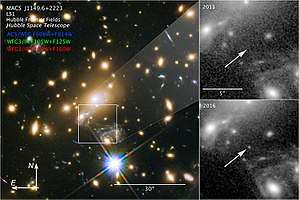2017 YE5
2017 YE5 is the provisional designation of a binary pair of asteroids of approximately equal size and mass, each about 0.9 km (0.56 mi) in diameter. Classified as a near-Earth asteroid and potentially hazardous object of the Apollo group, the primary component of the binary system was discovered by amateur astronomer Claudine Rinner at the Oukaïmeden Observatory on 21 December 2017. On 21 June 2018, the pair of asteroids passed within 15.5 lunar distances or 6 million km (3.7 million mi) from Earth, which will be their closest encounter for the next 170 years.[5] During the close encounter with Earth in 2018, radar observations of 2017 YE5 were carried out by the Arecibo Observatory and Goldstone Solar System Radar, which revealed the presence of the secondary component of the binary system. The discovery that 2017 YE5 was a binary asteroid was announced in a NASA press release in July 2018.[10]
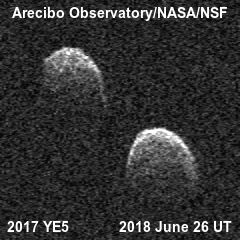 | |
| Discovery [1][2] | |
|---|---|
| Discovered by | Claudine Rinner |
| Discovery site | Oukaïmeden Obs. |
| Discovery date | 21 December 2017 |
| Designations | |
| 2017 YE5 | |
| tltv005 [3][4] | |
| Apollo · PHA · NEO [5] | |
| Orbital characteristics [5] | |
| Epoch 31 May 2020 (JD 2459000.5) | |
| Uncertainty parameter 2 | |
| Observation arc | 0.74 yr (270 days) |
| Earliest precovery date | 12 December 2017 |
| Aphelion | 4.818 AU |
| Perihelion | 0.818 AU |
| 2.818 AU | |
| Eccentricity | 0.70964 |
| 4.73 yr (1,728 days) | |
| 155.681° | |
| 0° 12m 29.952s / day | |
| Inclination | 6.218° |
| 103.927° | |
| 110.794° | |
| Earth MOID | 0.0209 AU |
| TJupiter | 2.877 |
| Physical characteristics | |
Mean diameter | 0.90±0.05 km or 900±50 m (for each body)[6][7] |
Mean density | <1 g/cm3[6][7] |
| 22.08±1.92 h (if synchronous)[6] 20.6±0.1 h (light curve)[5][8] | |
| 0.02[6][8] <0.03[7] | |
| S (assumed)[8] | |
| 26.8[9] | |
| 19.2[5] | |
2017 YE5 is an equal-mass binary asteroid, which are thought to be rare among the population of binary near-Earth asteroids. The pair of asteroids mutually orbit each other around a common center of mass (barycenter) between them, with a separation distance of about 1.8 km (1.1 mi). They orbit around their barycenter in 22 hours (0.92 days) and are both tidally locked to each other, in which their rotation periods are synchronous with their orbital periods.[6] Radar observations of the binary system have shown that their surface brightnesses and reflectivities appear to differ, indicating that the two components may have different densities, compositions, or surface roughnesses. These physical differences and similarities between the components of the 2017 YE5 binary system can help astronomers deduce and understand the compositions, internal structures, and formation mechanisms of equal-mass binary asteroids similar to 2017 YE5.[11][10]
Discovery
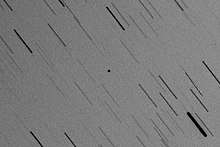
2017 YE5 was discovered on 21 December 2017, by French amateur astronomer Claudine Rinner at the Oukaïmeden Observatory in Marrakesh, Morocco.[12] The discovery formed part of the Morocco Oukaïmeden Sky Survey (MOSS) directed by Zouhair Benkhaldoun at the Cadi Ayyad University. The MOSS survey was designed for searching and characterizing the orbits of small Solar System bodies such as near-Earth asteroids and comets.[13] As the sixth near-Earth asteroid discovered by the MOSS survey,[14] 2017 YE5 was found in images taken by the Oukaïmeden Observatory's 0.5-meter reflecting telescope, which was remotely operated by Rinner.[1][13] At the time of discovery, 2017 YE5 was about 1.1 AU (160 million km; 100 million mi) away from Earth, located in the constellation of Gemini at an apparent magnitude of 19.8.[15][lower-alpha 1]
The discovery of 2017 YE5 was subsequently reported to the Minor Planet Center's near-Earth object confirmation page (NEOCP), where a preliminary orbit was calculated from additional observations conducted at multiple observatories.[4] Follow-up observations of 2017 YE5 spanned six days since its discovery, and the object was formally announced in a Minor Planet Electronic Circular issued by the Minor Planet Center on 27 December 2017.[1]
Precovery observations of 2017 YE5 were first identified and reported to the Minor Planet Center in February 2018. These observations were from the Mount Lemmon Survey, which had observed 2017 YE5 on 14 December 2017, seven days prior to its discovery by the Oukaïmeden Observatory.[2][16] Although the Jet Propulsion Laboratory's Asteroid Radar Research team credits 2017 YE5's discovery to the Mount Lemmon Survey,[17] the Minor Planet Center formally considers the Oukaïmeden Observatory to be the first observer and discoverer of 2017 YE5.[2] Earlier precovery observations by the Pan-STARRS 1 survey on 12 December 2017 were later identified in May 2018, and are now known to be the earliest reported observations of 2017 YE5.[2][18]
Nomenclature
Upon discovery, the asteroid was given the temporary internal designation tltv005.[3][4] After follow up observations confirming the object, it was then given the provisional designation 2017 YE5 by the Minor Planet Center on 27 December 2017.[1] The provisional designation signifies the object's discovery date and year, with the second letter and numbers indicating that it is the 130th object discovered during the second half of December 2017.[19][lower-alpha 2] 2017 YE5 has not yet been issued a permanent minor planet number by the Minor Planet Center due to its short observation arc of 270 days, which is insufficient for an orbit to be accurately determined.[5][2] 2017 YE5 is expected to receive a minor planet number once it has been observed for over at least four oppositions, which would take several years.[19] Once it receives a minor planet number, it will be eligible for naming.[19]
Orbit and classification
2017 YE5 orbits the Sun at an average distance of approximately 2.82 astronomical units (0.422×109 km; 0.262×109 mi), taking 4.73 years to complete one full orbit. The orbit of 2017 YE5 is slightly inclined to the ecliptic plane by 6.2 degrees, with its longest apsis oriented below the ecliptic. 2017 YE5 has a highly elongated orbit, with an orbital eccentricity of 0.71. Over the course of its orbit, 2017 YE5 approaches 0.82 AU from the Sun at perihelion and recedes 4.82 AU from the Sun at aphelion, beyond the outer extent of the asteroid belt.[20]

At aphelion, 2017 YE5 approaches close to Jupiter's orbit, with a minimum orbital intersection distance of 0.42 AU.[5][2] At such close proximity to Jupiter's orbit, 2017 YE5 has likely been gravitationally perturbed by Jupiter, as indicated by its Tisserand parameter of 2.877, which is considered to be characteristic of comets.[5][17] Because of its comet-like Tisserand parameter and relatively large orbit for a near-Earth object, 2017 YE5 has been suspected to be an extinct Jupiter-family comet.[17]
The orbit of 2017 YE5 crosses that of Earth's, thus it can occasionally make close approaches to the planet, making it a near-Earth object. With a semi-major axis (average orbit distance) greater than 1 AU and a perihelion distance within that of Earth's, 2017 YE5 is formally classified under the Apollo group of near-Earth asteroids.[5][2] Its minimum orbital intersection distance (MOID) from Earth is approximately 0.021 AU (3.1 million km; 2.0 million mi), or about 8 lunar distances.[5] Having such a small Earth MOID, 2017 YE5 is considered a potentially hazardous asteroid (PHA) by the Minor Planet Center, under the definition that PHAs have Earth MOIDs less than 0.05 AU and absolute magnitudes under 22.[2][21]
Despite being considered potentially hazardous, there is no risk of impact by 2017 YE5, as it will not make any close Earth encounters within 12 lunar distances or 0.03 AU (4.5 million km; 2.8 million mi) over the next 200 years.[5] Additional observations and refinements of 2017 YE5's orbit have ruled out future possibilities of Earth impacts, hence it was subsequently removed from the JPL Sentry Risk Table on 6 January 2018.[16][22]
2018 Earth approach
On 21 June 2018 at 20:53 UTC, 2017 YE5 passed 0.03986 AU (5.96 million km; 3.71 million mi), or 15.52 lunar distances, from Earth.[5] During its close approach to Earth, 2017 YE5 approached Earth at a rate of 15.5 km/s (35,000 mph) and its apparent visual brightness peaked around magnitude 15, too faint to be seen with the naked eye.[5][17] At closest approach, 2017 YE5's apparent motion in the sky was 0.51 degrees per hour and was in the constellation of Andromeda, at an apparent magnitude of 16.6 and an angular separation of 66 degrees from the Sun.[23][lower-alpha 3] After the close encounter with Earth, 2020 YE5 continued its approach to aphelion, passing by Mars from a nominal distance of 0.0441 AU (6.60 million km; 4.10 million mi) on 30 June 2018.[5][12]
Observations
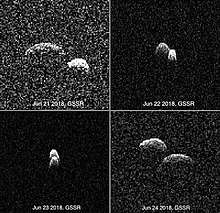
The June 2020 encounter with 2020 YE5 provided an opportunity for radar observatories to study the asteroid's characteristics in detail as it has been target of interest for astronomers, particularly for its low albedo and possible cometary origin.[17][24] The first radar observations of 2017 YE5 were conducted on 17 June 2018, with the monostatic Goldstone Solar System Radar (GSSR) in California. Initially, 2017 YE5 was not detected due to uncertainties in the radar pointing position, though it was later successfully imaged and observed with the GSSR on 21 June 2018, which revealed that 2017 YE5 was a binary pair of asteroids. Led by radar astronomer Marina Brozović, GSSR observations of 2017 YE5 spanned four days, lasting until 24 June 2018.[17] Radar observations by the GSSR have provided preliminary information on 2017 YE5's characteristics, hence a notice was reported to astronomers at the Arecibo Observatory in Puerto Rico for further study.[10][12]
Arecibo radar observations of 2017 YE5 began on 23 June 2018, as it was only visible to Arecibo from 22–26 June 2018.[17] The 2017 YE5 binary system was observed using a bistatic radar system, in which the Arecibo Observatory transmitted a radar signal to the pair of asteroids while the Green Bank Observatory in West Virginia received the signal reflected from the asteroids.[10][12] Led by Arecibo radar astronomers Anne Virkki, Flaviane Venditti, Sean Marshal, along with Patrick Taylor at the Green Bank Observatory, bistatic radar observations resolved 2017 YE5 at resolution of 7.5 meters per pixel.[11] Radar observations of 2017 YE5 ended on 26 June 2018, nevertheless astrometric measurements and observations of 2017 YE5 continued after its close approach to Earth.[17][25]
Future approaches
Over the course of its orbit in the next 200 years, 2017 YE5 will continue to pass by Earth, though it will not make any approaches as close as the June 2018 encounter. The next Earth encounter by 2017 YE5 will be in April 2037, when it will pass by Earth from a nominal distance of 0.2385 AU (35.68 million km; 22.17 million mi).[5][12] In the next 100 years, 2017 YE5 will make three Earth encounters within 0.2 AU (approximately 80 lunar distances), which will occur in February 2051, July 2088, and May 2107. The expected nominal approach distances for these dates are 0.123 AU, 0.179 AU, and 0.145 AU, respectively.[5]
Physical characteristics
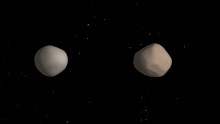
Both components of 2017 YE5 are approximately 0.9 km (0.56 mi) in diameter, and have dark surfaces with albedos less than 0.03.[7]
Satellite
 Animation of bistatic radar images of 2017 YE5 from Arecibo and Green Bank Observatory | |
| Discovery[17] | |
|---|---|
| Discovered by | Marina Brozović (first observer) |
| Discovery site | Goldstone Obs. |
| Discovery date | 21 June 2018 (first observed) |
| Orbital characteristics[6] | |
| 1.8 km (separation from primary) | |
| 0.92±0.08 d | |
| Satellite of | 2017 YE5 |
| Physical characteristics[6] | |
Mean diameter | 0.90±0.05 km or 900±50 m |
| 22.08±1.92 h (if synchronous) <24 h (constraint)[7] | |
| Albedo | 0.02 <0.03[7] |
| ≈19.3[6] | |
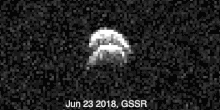
Notes
- The celestial coordinates of 2017 YE5 at the time of discovery were 07h 06m 15.35s −21° 17′ 11.9″.[1] See Gemini for constellation coordinates.
- In the convention for minor planet provisional designations, the first letter represents the half-month of the year of discovery while the second letter and numbers indicate the order of discovery within that half-month. In the case for 2017 YE5, the first letter 'Y' corresponds to the second half-month of December 2017 while the succeeding letter 'E' indicates that it is the 5th object discovered on the 6th cycle of discoveries (with 5 cycles completed). Each completed cycle consists of 25 letters representing discoveries, hence 5 + (5 completed cycles × 25 letters) = 130.[19]
- The celestial coordinates of 2020 YE5 at 20:53 UTC are 00h 39m 07.692s +45° 13′ 22.92″. The solar elongation at the time was 66.3 degrees.[23] See Andromeda for constellation coordinates.
References
- Rinner, C.; et al. (27 December 2017). "MPEC 2017-Y116: 2017 YE5". Minor Planet Electronic Circular. Minor Planet Center. Retrieved 16 February 2020.
- "2017 YE5". Minor Planet Center. International Astronomical Union. Retrieved 18 February 2020.
- "MPC official report for MOSS station". Société jurassienne d'astronomie. 30 May 2018. Retrieved 22 February 2020.
- "2017 YE5". NEO Exchange. Las Cumbres Observatory. 21 December 2017. Retrieved 16 February 2020.
- "JPL Small-Body Database Browser: 2017 YE5" (2018-09-08 last obs.). Jet Propulsion Laboratory. 27 July 2019. Retrieved 16 February 2020.
- Johnston, Wm. Robert (27 May 2019). "2017 YE5". Johnston's Archive. Retrieved 16 February 2020.
- Taylor, P. A.; Rivera-Valentín, E. G.; Virkki, A. K.; Warner, B. D.; Oey, J.; Venditti, F. C. F.; et al. (March 2019). Radar and Optical Observations of Equal-Mass Binary Near-Earth Asteroids (190166) 2005 UP156 and 2017 YE5 (PDF). 50th Lunar and Planetary Science Conference. The Woodlands, Texas: Lunar and Planetary Institute. Bibcode:2019LPI....50.2945T. 2945. Retrieved 18 February 2020.
- "LCDB Data for 2017 YE5" (Object name "2017 YE5"). Asteroid Lightcurve Database (LCDB). Retrieved 16 February 2020.
- "2017YE5". Near Earth Objects – Dynamic Site. Department of Mathematics, University of Pisa, Italy. Retrieved 16 February 2020.
- Cofield, Calla; Wendel, JoAnna (11 July 2018). "Observatories Team Up to Reveal Rare Double Asteroid". Jet Propulsion Laboratory. NASA. Retrieved 12 July 2018.
- Virkki, A. K. (12 July 2018). "Observatories Team Up to Reveal Rare Double Asteroid". Planetary Radar Science Group. NAIC-Arecibo Observatory. Retrieved 18 February 2020.
- Davis, Jason (24 July 2018). "Planetary Society asteroid hunters help find rare type of double asteroid". The Planetary Society. Retrieved 24 July 2018.
- Davis, Jason (3 July 2018). "Planetary Defense in the Moroccan Mountains". The Planetary Society. Retrieved 28 July 2018.
- "MOSS-Observatory [Morocco Oukaïmeden Sky Survey]". Société jurassienne d'astronomie. 9 August 2018. Retrieved 18 February 2020.
- "2017YE5 Ephemerides". Near Earth Objects – Dynamic Site (Ephemerides at discovery). Department of Mathematics, University of Pisa, Italy. Retrieved 22 February 2020.
- "M.P.S. 867675" (PDF). Minor Planet Circular. Minor Planet Center. 18 February 2018. Retrieved 21 February 2020.
- Benner, Lance A. M. (June 2018). "Goldstone Radar Observations Planning: Asteroids 2017 YE5, 1996 AW1, 2010 NY65, and 2018 LK". Asteroid Radar Research. Jet Propulsion Laboratory. Retrieved 18 July 2018.
- "M.P.S. 889315" (PDF). Minor Planet Circular. Minor Planet Center. 13 May 2018. Retrieved 1 March 2020.
- "How Are Minor Planets Named?". Minor Planet Center. International Astronomical Union. Retrieved 18 February 2020.
- Plait, Phil (3 September 2018). "2017 YE5: A rare binary asteroid caught on radar". Bad Astronomy. Syfy Wire. Retrieved 18 February 2020.
- "PHA (Potentially Hazardous Asteroid)". Center for Near Earth Object Studies. Jet Propulsion Laboratory. Retrieved 18 February 2020.
- "Sentry: Earth Impact Monitoring – Removed Objects". Center for Near Earth Object Studies. Jet Propulsion Laboratory. Retrieved 18 February 2020.
- "2017YE5 Ephemerides". Near Earth Objects – Dynamic Site (Ephemerides at 21 June 2018 approach). Department of Mathematics, University of Pisa, Italy. Retrieved 1 March 2020.
- Bartels, Meghan (12 July 2018). "Cosmic Double Take: Rare Binary Asteroid Discovered Near Earth". Space.com. Retrieved 18 February 2020.
- "M.P.S. 900357" (PDF). Minor Planet Circular. Minor Planet Center. 1 July 2018. Retrieved 2 March 2020.
External links
- Observatories Team Up to Reveal Rare Double Asteroid (press release), NASA Jet Propulsion Laboratory, 11 Jul 2018
- Goldstone Radar Observations Planning: Asteroids 2017 YE5, 1996 AW1, 2010 NY65, and 2018 LK, JPL Asteroid Radar Research, Jun 2018
- Planetary Society asteroid hunters help find rare type of double asteroid, Jason Davis, The Planetary Society, 24 Jul 2018
- 2017 YE5, Asteroids with Satellites Database, Johnston's Archive, 27 May 2019
- 2017 YE5 at NeoDyS-2, Near Earth Objects—Dynamic Site
- Ephemeris · Obs prediction · Orbital info · MOID · Proper elements · Obs info · Close · Physical info · NEOCC
- 2017 YE5 at the JPL Small-Body Database
